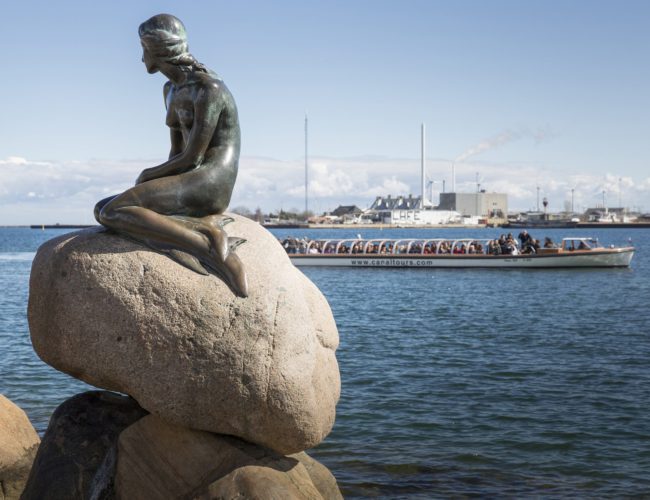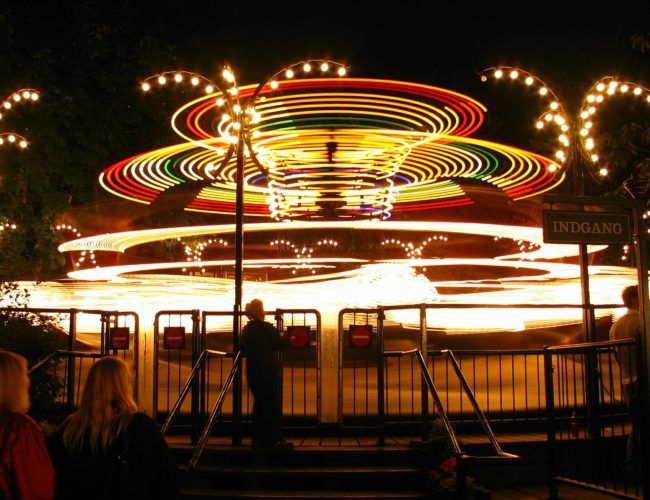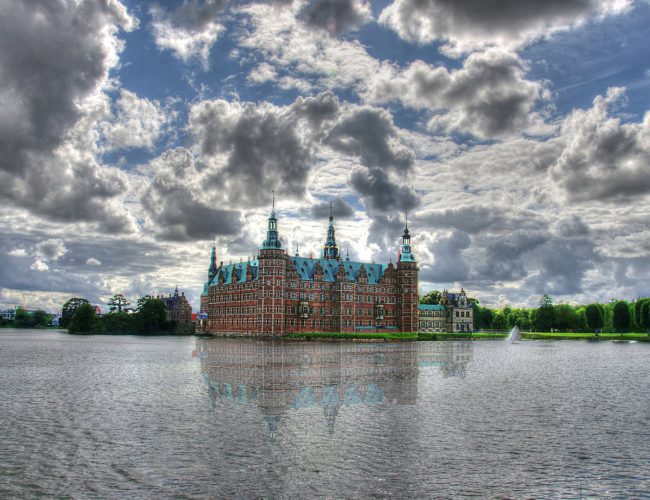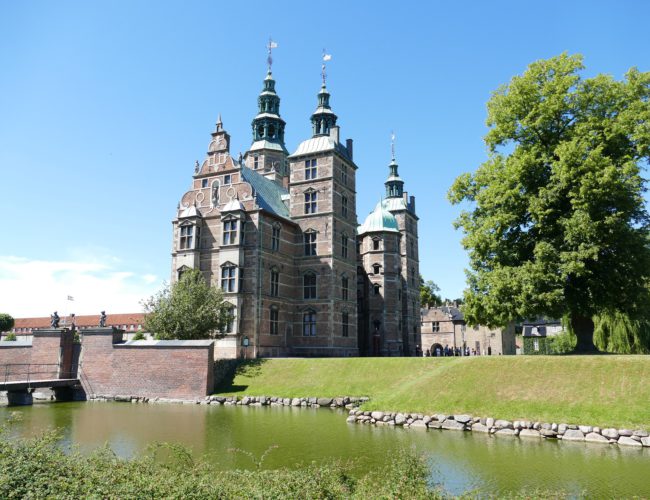Friendly disclaimer! We want to be as accurate as possible, but given these challenging times, we urge you to recheck that the venues are open when you decide to travel.
Fairy tales from our childhood, written by Denmark’s Hans Christian Anderson, spring to life in Copenhagen, the setting of many of those fabled stories. The city’s castles, gardens and views inspired Walt Disney and the Frozen series too, drawing from the many otherworldly places around. Here are some of its most magical spots that you do not want to miss.
Hans Christian Andersen Fairytale House
Get up close and personal with Denmark’s most beloved poet and author at the Hans Christian Andersen Fairytale House. The museum covers in detail his fantastic world, his childhood in Odense, his move to Copenhagen where he spent much of his adolescence and his travels which inspired his fairy tales. Have a look and listen to the great writertoo, giving his personal account of his life and travels abroad. A hand-written manuscript and a collection of props and appliances in the museum add significance to his extraordinary life.
A series of brilliant tableaux and ‘live’ exhibits with state-of-the-art lighting effects and a tri-lingual sound system in Danish, English and German, depict his stories in vivid detail.
Opening Hours: Every day of the week, (Sun-Sat) 10:00 hrs – 17:00 hrs. The museum remains open during Christmas and New Year, December 24-25 and 31, between 10:00-16:00. January 1 from 12:00-18:00.
The Little Mermaid (Den Lille Havfrue)
Arguably one of the most photographed statues in the world and Copenhagen’s most iconic attractions, the bronze-granite sculpture of The Little Mermaid is inspired by Hans Christian Andersen’s famous fairy tale from 1836. The statue was Danish brewer Carl Jacobsen’s gift to Denmark, installed over a hundred years ago in 1913. Jacobsen was so captivated by a ballerina’s performance in a production by the Royal Danish Theatre, that he commissioned the sculpture of this enduring icon.
Disney’s movie version of the story (with a happier ending than the original!) is about a 15 year old mermaid, who saves the life of a shipwrecked prince but must pay the price, by either losing her tail or being turned to foam, for her desire to be united with him as a human being. The mermaid’s melancholic expression is captured in bronze, as she looks longingly out to sea for her beloved.
A victim of vandals too, the sculpture has lost her arm, her head and endured having paint poured over her Rescued and restored each time, she has proven her place by the water, to welcome you to Copenhagen’s harbour.
Unravelog Tip: Several other avatars of the famous Little Mermaid are on display around Copenhagen. Should you wish to hunt these other treasures, there’s the Genetically Modified Mermaid, Havfrue, Merman with Seven Sons and Han Statue.

Tivoli Park
COVID-19 related info: The Park Opens again on the 27th of March, 2021. All visitors that are 15 years or older must submit a COVID Negative Test (that is not more than 72 hours old) along with their ID. It is also important to book the time of arrival prior to the visit. Some rides require booking from the Tivoli App.
“When people are amused, they do not think of politics!” – with this insightful observation, Georg Cartensen, persuaded King Christian VIII to commission Tivoli Park in 1843, (the world’s second oldest amusement park). It is Scandinavia’s most visited amusement park, and even today, Tivoli has a stunning variety of delights.
Enjoy the merry-go-round and boat rides, restaurants and cafes, Chinese harlequin theatre (designed like a peacock), resident symphony orchestras, gardens lit at night with thousands of coloured lamps and little lights. This was the inspiration for Walt Disney’s Disney World, writer Hans Christian Andersen’s fairy tales, the Beatles who played here, and Michael Jackson who wished to even buy it outright! Tranquil Tivoli is full of fountains, gorgeous gardens and quiet benches to admire the beauty all around.
Tivoli’s quirks and details add great charm – like the guinea fowls with their unique running style wandering the gardens. Tivoli’s oldest, most popular ride, the wooden Roller Coaster from 1914, still has a brakeman on board every train. Vertigo on the other hand, turns you upside down racing at 100 km/h! Dare yourself to ride the Dæmonen (The Demon) roller coaster – dangling your legs during the ride. And there’s The Star Flyer, The Flying Trunk and Rutschebanen to try.
And the food! Plan picnics or sample cuisine in great restaurants. Traditional Danish, French bistros, Asian and Michelin-awarded Kiin Kiin Piin To in the Chinese Tower, and the Tivoli Food Hall – where you will be spoiled for choice. Try Islandic dishes at Glò, delicious hot flatbread at North-African Wakha, the classy Nimb and Nimb Hotel, which offers a variety of different restaurants for traditional Danish smørrebrød (open-faced sandwiches). The eco-based Gemyse, an urban garden restaurant focuses on dishes with high quality vegetables. Pop into Cakenhagen for delicious coffee, cakes and champagne.
If it’s music you’re after, Tivoli has exciting events such as Friday Rock and Summer Classic, with live music every single day (check if this is still available post-pandemic). Upcoming Danish artists from both popular and more niche-specific genres play at the Little Friday, announced on Thursdays, Mundo Monday features music from all over of the world, Tuesday Tunes and Jazzy Wednesdays bring Danish songs and evergreens and Saturday nights present Tivoli’s Big Band and Tivoli Late Night Orchestra. Get on your feet, with Saturday Swing at Plænen, where both amateurs and experienced dancers rip the floors! You will need four hours – if you plan on eating lunch and dinner elsewhere, or seven hours if you wish to catch a show or plan a leisurely meal. Plan your time at Tivoli around activities and stay until nightfall to enjoy beautiful lights and illumination shows.
Opening hours: 11 am from April until late September and closes anywhere from 10 pm to 12:30 am, depending on the day and season. Also, open in October for Halloween and a Christmas Market from mid-November until nearly January.
Unravelog Tip: Download the Tivoli app so that you know when parades, pantomimes, and other productions will occur to ensure you don’t miss a beat!

Fairy tales canals cruise
Spot the visual clues and listen to those familiar fairy tales from your childhood as you cruise along Copenhagen’s coast, recalling your favourite stories from Hans Christian Andersen. Open to all ages, an onboard fairytale character welcomes you at the dock where you’ll board a canal boat. For approximately one hour, your hostess will fill you with stories relating to the many sites connected with some of his stories, from classics like The Little Mermaid and Frozen. Catch historic canals and sail by landmarks like the Amalienborg Palace and the statue of The Little Mermaid, on this happy hour down the canal.
Frederiksborg castle
Castles have been synonymous with fairy tales involving the lives and loves of princes, princesses, queens and kings, all royalty and fantasy! Frederiksborg Castle is among the most famous in Denmark for its picture-perfect profile: situated in three islands surrounded by a lake and beautiful gardens. Home to the Museum of National History, the castle and grounds are full of tales. Here, 500 years of Danish history is illustrated through portraits, paintings, furniture, sculptures and decorative art, people and events that shaped Denmark, from the Middle Ages to the 21st century.
Frederiksborg Castle is the largest Renaissance castle in Scandinavia, built in the early 17th century as a showpiece of King Christian IV’s powerful monarchy. Gaze at the best examples of Renaissance architecture and craftsmanship – for example, the impressive Neptune Fountain and the Marble Gallery of the King’s Wing. Impressive portraits at the museum include Johan Friedrich Struensee and Queen Caroline Mathilde by artist Jens Juel, paintings by artists Karel van Mander, Wilhelm Marstrand, P. S. Krøyer, Niels Strøbæk, and others.
A fire broke out in 1859, and the greater part of the interior of the castle, except the chapel, was destroyed. It was restored and rebuilt by J. C. Jacobsen. Even today, kings and queens are anointed in the chapel at Frederiksborg Castle.
Note the symmetrical castle garden created by architect J. C. Krieger in 1725. This baroque style complete with festive cascades and parterre flower beds was restored to its original design in 1996. This garden is home to the charming Bath House, occasionally used as a lodge by the Royal Family during hunt lunches.
Opening hours: Monday to Sunday, 10 am – 5 pm ( April 1 – October 31) and 11 am – 3 pm (November 1 – March 31)
Unravelog Tip: Looking for some unusual photographic compositions to make your friends envious? Walk around the castle lake for great views, after you’ve explored the castle and strolled through the Baroque gardens.

Kronborg castle
This is a celebrated castle, not the least of which is its relationship to Shakespeare. Hamlet, Prince of Denmark, the Shakespearean tragedy written between 1599 and 1602, is the setting for the Prince’s home, Elsinore, (anglicized version of Helsingør). Kronborg castle is also a UNESCO world heritage site, and among north Europe’s most important Renaissance castles.
Strategically located on the coast on the strait of Oresund, it looks across the water to south Sweden (Scania), which used to belong to Denmark for most of history. The Danish king also had a powerful fortress on the other side and controlled the passage in and out of the Baltic Sea, collecting taxes from trade ships, and financing more than a third of the expenses of Denmark then.
‘Kronborg’ translates to ‘Crown Castle’. Built over, enlarged and finished in 1585, the castle has not changed much since! Though Kronborg caught fire in 1629 and most of the rooms except the church had their interior destroyed. The rooms were renovated in the 1630s by King Christian IV; and over time, the interiors, decorations and the paintings on the ceiling were restored. Look for the initials ‘CIV’ all over the castle!
History has it that in 1658, Kronborg was conquered by Sweden in a disastrous war. The Danes lost Southern Sweden which almost ruined Denmark. (To save their national pride, Danes say the Swedes only won because they got lucky – the sea froze over and they could walk across the ice!).
Kronborg was world-famous before Shakespeare wrote Hamlet, because of the royal wedding between a Danish princess and the crown prince of England. Legend has it that the Viking, Holger the Dane, a legendary warrior who sits in the basement of the castle will wake up and fight for his country if Denmark is ever attacked!
Unravelog Tip: In summer, enjoy live performances of local and international theatre companies, including the Royal Shakespeare Company and other Shakespeare events for all the family at HamletScenen’s Shakespeare Festival at the castle.
Rosenborg castle
Every castle must have its treasure – and the Rosenborg Castle guards them in its basement. All the royal crown jewels and the royal crowns, complete sets of ruby, diamond, pearl and an emerald set, considered among the world’s finest, are housed here. The Crown Jewels are still being used today by the current Danish Queen.
Though now not used as a residence by royals, this 1600s ‘pleasure palace’ was built in a Dutch Renaissance style by King Christian IV, with high towers and red brick walls. Its popular garden, Denmark’s oldest, with beautiful trees and flowerbeds, blooms through summer and spring. The statue of Hans Christian Andersen stands here among many other sculptures.
You’ll find beautifully well-preserved interiors, furnished as they would have been in the times of earlier kings. Even if you aren’t familiar with Danish history, some items are of such exceptional quality, that it’s worth taking a closer look. Check out the Great Hall on the second floor, with its three silver lions to protect the royal thrones.
Arrive at opening times in busy months, to receive a map, with the layout and route through three floors of the museum and two more in the cellars housing the treasury and crown jewels. Free wifi is available with an audio guide and QR-codes making it easy to obtain more information if desired.
Opening hours: Open usually at 10:00 (but 9:00 from June to August). Closing time ranges from 15:00 to 17:00. Closed Mondays from November to mid-April but may be open during holiday periods.







